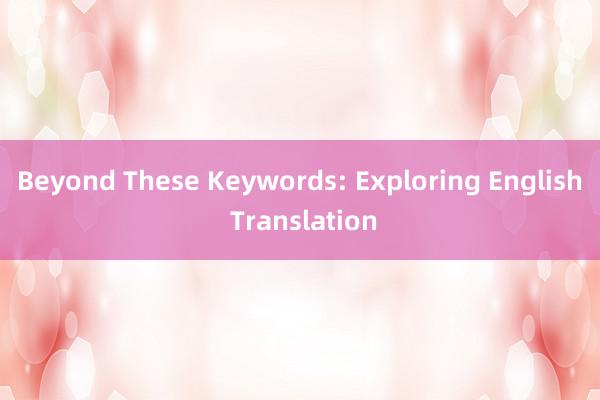
### Beyond These Keywords: Exploring English Translation
In the vast field of language, translation serves as a bridge, connecting people across different linguistic boundaries. The art and science of translating texts from one language to another, particularly from English to other languages, involves more than just the mechanical process of word-for-word conversion. It requires an understanding of cultural nuances, idiomatic expressions, and the subtleties of language that cannot always be captured by direct translations. This article delves into the complexities and nuances of English translation beyond the mere keywords.
#### The Role of Context
One of the most significant aspects of effective translation is understanding the context in which the original text was written. Context includes not only the immediate surroundings of the text but also the historical, social, and cultural contexts. For instance, idioms and phrases that may seem straightforward in English can have vastly different meanings or no equivalent at all in other languages. Recognizing these differences and finding appropriate expressions that convey the same meaning and tone is crucial for maintaining the integrity of the message.
#### Cultural Sensitivity
Language is deeply intertwined with culture. Translators must navigate this cultural landscape carefully to avoid misinterpretations that could lead to offense or misunderstanding. For example, humor, 海口曼洁霆服装有限责任公司 sarcasm, 江阴市奥瑞吉金属制品有限公司 and even common metaphors might lose their effectiveness or meaning when translated directly. Understanding the cultural background of both the source and target audiences helps in choosing words and expressions that resonate culturally on both sides.
#### Idiomatic Expressions
Idioms and metaphors are a rich part of English,望江百耀晒图机有限公司 often carrying multiple layers of meaning. Direct translation of idioms can result in awkwardness or loss of meaning. Instead, translators must find a way to capture the essence of the idiom within the constraints of the target language's grammar and cultural norms. This might involve rephrasing the entire sentence or finding a similar idiom in the target language.
#### Technical and Legal Texts
邢台泵阀制造网-泵阀网,水泵,连云港佳磊国际贸易有限公司阀门,泵阀领域专业门户网站Translation of technical and legal documents requires precision and accuracy, as small errors can lead to significant consequences. These texts often contain specialized vocabulary and strict grammatical structures. Translators must have deep knowledge of both the source and target languages, as well as the specific fields they are translating, to ensure that the translation is not only linguistically accurate but also legally sound and technically correct.
#### Technology and Automation
While technology has revolutionized the translation industry with tools like machine translation (MT), it is still far from perfect. MT can provide quick translations but often lacks the nuance and cultural sensitivity that human translators excel at. Human translators are still indispensable, especially for complex texts where the subtleties of language and culture are paramount. However, technology can aid in post-editing, refining translations, and handling large volumes of content efficiently.
In conclusion连云港佳磊国际贸易有限公司, English translation transcends simple keyword matching; it involves a deep understanding of language, culture, context, and the art of conveying meaning effectively between languages. As we continue to explore the vast world of translation, embracing technological advancements while valuing the human touch will be key to achieving truly impactful and culturally sensitive translations.